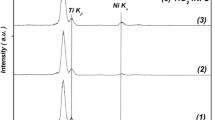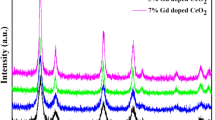Abstract
Cerium-incorporated TiO2 nano-composite powders were fabricated by a facile procedure included co-decomposition of the required chemical complexes. The structures of the synthesized composites were investigated by the X-ray diffraction (XRD) technique through Rietveld refinement method, which confirmed the formation of almost single anatase (A) phase. The formed tiny rutile (R) and Titania (B) phases were vanished with Ce doping and hydrogenation. The optical band-gap was red-shifted with Ce doping and blue-shifted with the hydrogenation. The results confirmed that the hydrogenation process was vital to create ferromagnetic (FM) properties in Ce-incorporated TiO2. A saturation magnetization of ~0.18 emu/cm3 was measured for the hydrogenated ~10 at% Ce sample.



Similar content being viewed by others
Abbreviations
- A:
-
Anatase phase
- B:
-
Titania B-phases
- BGN:
-
Band-gap narrowing
- CBs:
-
Crystallite boundaries
- CS:
-
Crystallite size
- CF:
-
Crystallites surfaces
- DRS:
-
Diffuse reflectance spectroscopy
- DMS:
-
Dilute magnetic semiconductor
- ECM:
-
Electronic crystalline medium
- E g :
-
Band-gap energy
- FM:
-
Ferromagnetic
- Hc :
-
Coercive force
- K-M:
-
Kubelka-Munk equation
- Mr :
-
Remanence
- Ms :
-
Saturation magnetization
- M. B:
-
Moss-Burstein
- PM:
-
Paramagnetic
- R:
-
Rutile phase
- RT-FM:
-
Room-temperature ferromagnetism,
- Rb:
-
Brookite phase
- SSS:
-
Substitutional solid solution
- TM:
-
Transition-metal
- VOs:
-
Oxygen vacancies
- VSM:
-
Vibrating sample magnetometer
- W-H:
-
Williamson-Hall
- XRD:
-
X-ray diffraction
- λg :
-
Absorption threshold wavelength
- μ:
-
Εffective magnetic moment
- χ(vol) :
-
Volume susceptibility
References
J. Tian, H. Gao, H. Deng, L. Sun, H. Kong, P. Yang, J. Chu, Structural, magnetic and optical properties of Ni-doped TiO2 thin films deposited on silicon (100) substrates by sol–gel process. J. Alloys Compd. 581, 318–323 (2013)
R. Marchand, L. Brohan, M. Tournoux, TiO2(B) a new form of titanium dioxide and the potassium octatitanate K2Ti8O17. Mater. Res. Bull. 15(8), 1129–1133 (1980). https://doi.org/10.1016/0025-5408(80)90076-8
J. Dong, J. Han, Y. Liu, A. Nakajima, S. Matsushita, S. Wei, W. Gao, Defective black TiOTiO2 synthesized via anodization for visible-light photocatalysis. Appl. Mater. Interfaces 6, 1385–1388 (2014)
A.G. Rana, W. Ahmad, A. Al-Matar, R. Shawabke, Z. Aslam, Synthesis and characterization of Cu–Zn/TiO2 for the photocatalytic conversion of CO2 to methane. Environ. Technol. 38(9), 1085–1092 (2017)
D.V. Bavykin, V.N. Parmon, A.A. Lapkin, F.C. Walsh, The effect of hydrothermal conditions on the mesoporous structure of TiO2 nanotubes. J. Mater. Chem. 14(22), 3370–3377 (2004)
J. Tian, Y. Leng, H. Cui, H. Liu, Hydrogenated TiO2 nanobelts as highly efficient photocatalytic organic dye degradation and hydrogen evolution photocatalyst. J. Hazard. Mater. 299, 165–173 (2015)
A. Ghicov, J.M. Macak, H. Tsuchiya, J. Kunze, V. Haeublein, L. Frey, P. Schmuki, Ion implantation and annealing for an efficient N-Doping of TiO2 nanotubes. Nano Lett. 6, 1080–1082 (2006)
L. Sun, J. Li, C.L. Wang, S.F. Li, H.B. Chen, C.J. Lin, An electrochemical strategy of doping Fe3+ into TiO2 nanotube array films for enhancement in photocatalytic activity. Sol. Energy Mater. Sol. Cells 93(10), 1875–1880 (2009)
G.L. Chiarello, M.H. Aguirre, E. Selli, Hydrogen production by photocatalytic steam forming of methanol on noble metal-modified TiO2. J. Catal. 273(2), 182–190 (2010)
Y. Zhang, H. Ma, M. Yi, Z. Shen, X. Yu, X. Zhang, Magnetron-sputtering fabrication of noble metal nanodots coated TiO2 nanoparticles with enhanced photocatalytic performance. Mater. Des. 125, 94–99 (2017)
A.M.T. Silva, C.G. Silva, G. Drazic, J.L. Faria, Ce-doped TiO2 for photocatalytic degradation of chlorophenol. Catal. Today 144, 13–18 (2009)
J.Y. Lee, J.-H. Choi, Sonochemical synthesis of Ce-doped TiO2 nanostructure: a visible-light-driven photocatalyst for degradation of Toluene and O-Xylene. Materials 16, 1386 (2019). https://doi.org/10.3390/ijerph16081386
A. Jafari, S. Khademi, M. Farahmandjou, Nano-crystalline Ce-doped TiO2 powders: Sol-gel synthesis and optoelectronic properties. Mater. Res. Express 5(9), 095008 (2018)
J. Dhanalakshmi, S. Iyyapushpam, S.T. Nishanthi, M. Malligavathy, D.P. Padiyan, Investigation of oxygen vacancies in Ce coupled TiO2 nanocomposites by Raman and PL spectra. Adv. Nat. Sci. Nanosci. Nanotechnol. 8, 015015 (2017) (10pp)
Y. Xu, C. Zhang, L. Zhang, X. Zhang, H. Yao, J. Shi, Pd-catalyzed instant hydrogenation of TiO 2 with enhanced photocatalytic performance. Energy Environ. Sci. 9(7), 2410–2417 (2016)
X. Chen, S.S. Mao, Titanium dioxide nanomaterials: Synthesis, properties, modifications, and applications. Chem. Rev. 107(7), 2891–2959 (2007)
U. Diebold, The surface science of titanium dioxide. Surf. Sci. Rep. 48(5-8), 53–229 (2003)
M. El-Hilo, A.A. Dakhel, Z.J. Yacoob, Magnetic interactions in Co2+ doped ZnO synthesized by co-precipitation method: Efficient effect of hydrogenation on the long-range ferromagnetic order. J. Magn. Magn. Mater. 482, 125–134 (2019)
B. Abdelhamid, G. Schmerber, D. Ihiawakrim, A. Derory, Structural, optical, and magnetic properties of polycrystalline Co-doped TiO2 synthesized by solid-state method. Mater. Sci. Eng. B 177, 1618–1622 (2012)
H.P. Quiroz, A.D. Cuenca, Synthesis temperature dependence on magnetic properties of cobalt doped TiO2 thin films for spintronic applications. Appl. Surf. Sci. 484(2–19), 688–691 (2019)
C. Jayachandraiah, G. Krishnaiah, Influence of cerium dopant on magnetic and dielectric properties of ZnO nanoparticles. J. Mater. Sci. 52(12), 7058–7066 (2017)
L. Gigliola, C. Barani, F. Giubertoni, G. Paganelli, Synthesis and characterization of TiO2 nanoparticles for the reduction of water pollutants. Materials-MDPI 10, 1208 (2017) (11 pages)
J.D. Hanawalt, H.W. Rinn, L.K. Frevel, Chemical analysis by X-ray diffraction. Ind. Eng. Anal. Chem. 10, 475–512 (1938)
C. Kittel, Introduction to Solid State Physics (Wiley, New York, 1996), p. 425
R.D. Shannon, Revised effective ionic radii and systematic studies of interatomic distances in halides and chalcogenides. Acta Crystallogr. A 32(5), 751–767 (1976)
L.B. McCusker, R.B. Von Dreele, D.E. Cox, D. Louer, P. Scardi, Rietveld refinement guidelines. J. Appl. Crystallogr. 32(1), 36–50 (1999)
A. Khorsand Zak, W.H. Abd Majid, M.E. Abrishami, R. Yousefi, X-ray analysis of ZnO nanoparticles by Williamson–Hall and size–strain plot methods. Solid State Sci. 13(1), 251–256 (2011)
P. Kubelka, F. Munk, Ein Beitrag Zur Optik Der Farbanstriche. Z. Tech. Physik 12, 593–601 (1931)
D. Fernández-Torre, J. Carrasco, M.V. Ganduglia-Pirovano, R. Pérez, Hydrogen activation, diffusion, and clustering on CeO2(111): A DFT+U study. J. Chem. Phys. 141, 014703 (2014)
R. Del Angel, J.C. Durán-Álvarez, R. Zanella, TiO2-Low band gap semiconductor heterostructures for water treatment using sunlight-driven photocatalysis, titanium dioxide - material for a sustainable environment, Dongfang Yang. IntechOpen (2018). https://doi.org/10.5772/intechopen.76501. Available from: https://www.intechopen.com/books/titanium-dioxide-material-for-a-sustainable-environment/TiO2-low-band-gap-semiconductor-heterostructures-for-water- treatment-using-sunlight-driven-photocata
S. Ahmad, W. Khan, A. Raushan, Synthesis and characterization of Ni doped TiO2 Nanoparticles by sol-gel method, conference: international conference on advanced materials for power engineering at: MGU, Kottayam Kerala, India (2015)
D.A.H. Hanaor, M.H.N. Assadi, S. Li, A. Yu, C.C. Sorrell, Ab initio study of phase stability in doped TiO2. Comput. Mech. 50, 185–194 (2012)
H. Wang, J. Wei, R. Xiong, J. Shi, Enhanced ferromagnetic properties of Fe+N codoped TiO2 anatase. J. Magn. Magn. Mater. 324(13), 2057–2061 (2012)
A. Kumar, M.K. Kashyap, N. Sabharwal, S. Kumar, A. Kumar, P. Kumar, K. Asokan, Structural, optical and weak magnetic properties of Co and Mn codoped TiO2 nanoparticles. Solid State Sci. 73, 19–26 (2017)
S. Zhou, E. Cizmar, K. Potzger, M. Krause, G. Talut, M. Helm, J. Fassbender, S.A. Zvyagin, J. Wosnitza, H. Schmidt, Origin of magnetic moments in defective single crystals. Phys. Rev. B 79(11), 113201 (4 pages) (2009)
R.L. Carlin, in Magnetochemistry. The rare earths or lanthanides (Springer, Berlin, 1986), pp. 237–261
J. Fikacek, J. Prokleska, J. Prchal, J. Custers, V. Sechovsky, Nature of the magnetic ground state in the mixed valence compound CeRuSn: a single-crystal study. J. Phys. Condens. Matter 25, 416006 (2013) (6pp)
S.-J. Cheng, Magnetic response of magnetic ion-doped nanocrystals: Effects of single Mn2+ impurity. Phys. Rev. B 72(23), 235332 (2005)
F. Tolea, M.N. Grecu, V. Kuncser, S.G. Constantinescu, D. Ghica, On the role of Fe ions on magnetic properties of doped TiO2 nanoparticles. Appl. Phys. Lett. 106, 142404 (2015)
M. Yeganeh, N. Shahtahmasebi, A. Kompany, M. Karimipour, F. Razavi, N.H.S. Nasralla, L. Siller, The magnetic characterization of Fe doped TiO2 semiconducting oxide nanoparticles synthesized by sol-gel method. Physica B 511, 89–98 (2017)
Z.N. Kayani, M.S. Riaz, S. Naseem, Magnetic and antibacterial studies of sol-gel dip coated Ce doped TiO2 thin films: Influence of Ce contents. Ceram. Int. 46, 381–390 (2020). https://doi.org/10.1016/j.ceramint.2019.08.272
Author information
Authors and Affiliations
Corresponding author
Additional information
Publisher’s note
Springer Nature remains neutral with regard to jurisdictional claims in published maps and institutional affiliations.
Rights and permissions
About this article
Cite this article
Dakhel, A.A. Influence of hydrogen and cerium dopant on structural, optical, and magnetic properties of anatase nanoparticles. J Electroceram 45, 22–28 (2020). https://doi.org/10.1007/s10832-020-00221-8
Received:
Accepted:
Published:
Issue Date:
DOI: https://doi.org/10.1007/s10832-020-00221-8




